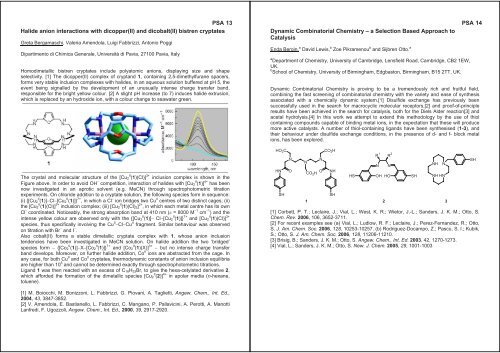ISMSC 2007 - Università degli Studi di Pavia
ISMSC 2007 - Università degli Studi di Pavia
ISMSC 2007 - Università degli Studi di Pavia
You also want an ePaper? Increase the reach of your titles
YUMPU automatically turns print PDFs into web optimized ePapers that Google loves.
PSA 13<br />
Halide anion interactions with <strong>di</strong>copper(II) and <strong>di</strong>cobalt(II) bistren cryptates<br />
Greta Bergamaschi, Valeria Amendola, Luigi Fabbrizzi, Antonio Poggi<br />
Dipartimento <strong>di</strong> Chimica Generale, <strong>Università</strong> <strong>di</strong> <strong>Pavia</strong>, 27100 <strong>Pavia</strong>, Italy<br />
Homo<strong>di</strong>metallic bistren cryptates include polyatomic anions, <strong>di</strong>splaying size and shape<br />
selectivity. [1] The <strong>di</strong>copper(II) complex of cryptand 1, containing 2,5-<strong>di</strong>methylfurane spacers,<br />
forms very stable inclusion complexes with halides, in an aqueous solution buffered at pH 5, the<br />
event being signalled by the development of an unusually intense charge transfer band,<br />
responsible for the bright yellow colour. [2] A slight pH increase (to 7) induces halide extrusion,<br />
which is replaced by an hydroxide ion, with a colour change to seawater green.<br />
The crystal and molecular structure of the [Cu2 II (1)(Cl)] 3+ inclusion complex is shown in the<br />
Figure above. In order to avoid OH competition, interaction of halides with [Cu2 II (1)] 4+ has been<br />
now investigated in an aprotic solvent (e.g. MeCN) through spectrophotometric titration<br />
experiments. On chloride ad<strong>di</strong>tion to a cryptate solution, the following species form in sequence:<br />
(i) {[Cu2 II (1)]Cl[Cu2 II (1)]} 7+ , in which a Cl ion bridges two Cu II centres of two <strong>di</strong>stinct cages; (ii)<br />
the [Cu2 II (1)(Cl)] 3+ inclusion complex; (iii) [Cu2 II (1)(Cl)2] 2+ , in which each metal centre has its own<br />
Cl coor<strong>di</strong>nated. Noticeably, the strong absorption band at 410 nm ( = 8000 M 1 cm 1 ) and the<br />
intense yellow colour are observed only with the {[Cu2 II (1)] Cl[Cu2 II (1)]} 7+ and [Cu2 II (1)(Cl)] 3+<br />
species, thus specifically involving the Cu II ClCu II fragment. Similar behaviour was observed<br />
on titration with Br and I .<br />
Also cobalt(II) forms a stable <strong>di</strong>metallic cryptate complex with 1, whose anion inclusion<br />
tendencies have been investigated in MeCN solution. On halide ad<strong>di</strong>tion the two ‘bridged’<br />
species form {[Co2 II (1)]X[Co2 II (1)]} 7+ and [Co2 II (1)(X)] 3+ but no intense charge transfer<br />
band develops. Moreover, on further halide ad<strong>di</strong>tion, Co II ions are abstracted from the cage. In<br />
any case, for both Cu II and Co II cryptates, thermodynamic constants of anion inclusion equilibria<br />
are higher than 10 5 and cannot be determined exactly through spectrophotometric titrations.<br />
Ligand 1 was then reacted with an excess of C16H33Br, to give the hexa-cetylated derivative 2,<br />
which afforded the formation of the <strong>di</strong>metallic species [Cu2 II (2)] 4+ in apolar me<strong>di</strong>a (n-hexane,<br />
toluene).<br />
[1] M. Boiocchi, M. Bonizzoni, L. Fabbrizzi, G. Piovani, A. Taglietti, Angew. Chem., Int. Ed.,<br />
2004, 43, 3847-3852.<br />
[2] V. Amendola, E. Bastianello, L. Fabbrizzi, C. Mangano, P. Pallavicini, A. Perotti, A. Manotti<br />
Lanfre<strong>di</strong>, F. Ugozzoli, Angew. Chem., Int. Ed., 2000, 39, 2917-2920.<br />
Dynamic Combinatorial Chemistry – a Selection Based Approach to<br />
Catalysis<br />
Enda Bergin, a David Lewis, b Zoe Pikramenou b and Sijbren Otto. a<br />
a<br />
Department of Chemistry, University of Cambridge, Lensfield Road, Cambridge, CB2 1EW,<br />
UK.<br />
b<br />
School of Chemistry, University of Birmingham, Edgbaston, Birmingham, B15 2TT, UK.<br />
Dynamic Combinatorial Chemistry is proving to be a tremendously rich and fruitful field,<br />
combining the fast screening of combinatorial chemistry with the variety and ease of synthesis<br />
associated with a chemically dynamic system.[1] Disulfide exchange has previously been<br />
successfully used in the search for macrocyclic molecular receptors,[2] and proof-of-principle<br />
results have been achieved in the search for catalysis, both for the Diels Alder reaction[3] and<br />
acetal hydrolysis.[4] In this work we attempt to extend this methodology by the use of thiol<br />
containing compounds capable of bin<strong>di</strong>ng metal ions, in the expectation that these will produce<br />
more active catalysts. A number of thiol-containing ligands have been synthesised (1-3), and<br />
their behaviour under <strong>di</strong>sulfide exchange con<strong>di</strong>tions, in the presence of d- and f- block metal<br />
ions, has been explored.<br />
HO 2C CO 2H<br />
N<br />
N<br />
HN O<br />
CO<br />
O NH<br />
2H<br />
N<br />
SH SH<br />
HS<br />
R 1<br />
R 2<br />
N N<br />
OH HO SH<br />
NH<br />
N<br />
NH HN<br />
1 2 3<br />
PSA 14<br />
[1] Corbett, P. T.; Leclaire, J.; Vial, L.; West, K. R.; Wietor, J.-L.; Sanders, J. K. M.; Otto, S.<br />
Chem. Rev. 2006, 106, 3652-3711.<br />
[2] For recent examples see (a) Vial, L.; Ludlow, R. F.; Leclaire, J.; Perez-Fernandez, R.; Otto,<br />
S. J. Am. Chem. Soc. 2006, 128, 10253-10257. (b) Rodriguez-Docampo, Z.; Pascu, S. I.; Kubik,<br />
S.; Otto, S. J. Am. Chem. Soc. 2006, 128, 11206-11210.<br />
[3] Brisig, B.; Sanders, J. K. M.; Otto, S. Angew. Chem., Int. Ed. 2003, 42, 1270-1273.<br />
[4] Vial, L.; Sanders, J. K. M.; Otto, S. New. J. Chem. 2005, 29, 1001-1003<br />
SH

















